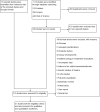Prevalence of Plasmodium spp. in Anopheles mosquitoes in Thailand: a systematic review and meta-analysis
- PMID: 35933389
- PMCID: PMC9357324
- DOI: 10.1186/s13071-022-05397-2
Prevalence of Plasmodium spp. in Anopheles mosquitoes in Thailand: a systematic review and meta-analysis
Abstract
Background: The entomological inoculation rate (EIR) is one of the key indices used to evaluate malaria transmission and vector control interventions. One of the components of the EIR is the sporozoite rate in Anopheles vectors. A systematic review and meta-analysis was performed to identify the prevalence of Plasmodium spp. in field-collected Anopheles species across Thailand.
Methods: This systematic review was registered under the PROSPERO number CRD42021297255. Studies that focused on the identification of Plasmodium spp. in Anopheles mosquitoes were identified from the electronic databases PubMed, Web of Science, and Scopus. The quality of the identified studies was determined using the Strengthening the Reporting of Observational Studies in Epidemiology approach. The proportion of Anopheles mosquitoes collected, Anopheles vectors for Plasmodium species, and specificity of Anopheles vectors for Plasmodium species were analyzed. The pooled prevalence of Plasmodium species among the primary vectors (Anopheles dirus, Anopheles minimus, and Anopheles maculatus) was estimated using the random-effects model.
Results: Of the 1113 studies identified, 31 were included in the syntheses. Of the 100,910 Anopheles mosquitoes identified for species and sibling species, An. minimus (40.16%), An. maculatus (16.59%), and Anopheles epiroticus (9.18%) were the most prevalent Anopheles species. Of the 123,286 Anopheles mosquitoes identified, 566 (0.46%) were positive for Plasmodium species. The highest proportions of Plasmodium species were identified in Anopheles hodgkini (2/6, 33.3%), Anopheles nigerrimus (2/24, 8.33%), Anopheles balabacensis (4/84, 4.76%), An. dirus (114/4956, 2.3%), Anopheles annularis (16/852, 1.88%), Anopheles kochi (8/519, 1.54%), Anopheles vagus (3/215, 1.4%), and Anopheles baimaii (1/86, 1.16%). The pooled prevalence of Plasmodium species identified in the main Anopheles vectors was 0.4% of that of Plasmodium species identified in An. dirus was 2.1%, that of Plasmodium species identified in An. minimus was 0.4%, and that of Plasmodium species identified in An. maculatus was 0.4%.
Conclusions: We found a low prevalence of Plasmodium infection in Anopheles mosquitoes across Thailand. Therefore, the use of EIR to determine the impact of vector control intervention on malaria parasite transmission and elimination in Thailand must be undertaken with caution, as a large number of Anopheles specimens may be required.
Keywords: Anopheles; Meta-analysis; Plasmodium; Thailand.
© 2022. The Author(s).
Conflict of interest statement
The authors declare that they have no competing interests.
Figures







Similar articles
-
Anopheles bionomics in a malaria endemic area of southern Thailand.Parasit Vectors. 2021 Jul 27;14(1):378. doi: 10.1186/s13071-021-04870-8. Parasit Vectors. 2021. PMID: 34315509 Free PMC article.
-
Survey of malaria vectors on the Cambodia, Thailand and China-Laos Borders.Malar J. 2022 Dec 30;21(1):399. doi: 10.1186/s12936-022-04418-w. Malar J. 2022. PMID: 36585690 Free PMC article.
-
Natural human Plasmodium infections in major Anopheles mosquitoes in western Thailand.Parasit Vectors. 2016 Jan 13;9:17. doi: 10.1186/s13071-016-1295-x. Parasit Vectors. 2016. PMID: 26762512 Free PMC article.
-
Systematic review of sporozoite infection rate of Anopheles mosquitoes in Ethiopia, 2001-2021.Parasit Vectors. 2023 Nov 27;16(1):437. doi: 10.1186/s13071-023-06054-y. Parasit Vectors. 2023. PMID: 38008761 Free PMC article. Review.
-
Malaria entomological profile in Tanzania from 1950 to 2010: a review of mosquito distribution, vectorial capacity and insecticide resistance.Tanzan J Health Res. 2011 Dec;13(5 Suppl 1):319-31. Tanzan J Health Res. 2011. PMID: 26591987 Review.
Cited by
-
Longitudinal field evaluation of outdoor Anopheles and non-Anopheles host-seeking in response to a volatile pyrethroid spatial emanator (SE) product among forest-dwelling indigenous residents of Sumatra, Indonesia.Malar J. 2025 Apr 10;24(1):118. doi: 10.1186/s12936-025-05284-y. Malar J. 2025. PMID: 40211345 Free PMC article.
-
Interleukin-5 levels in relation to malaria severity: a systematic review.Malar J. 2023 Aug 3;22(1):226. doi: 10.1186/s12936-023-04659-3. Malar J. 2023. PMID: 37537570 Free PMC article.
-
Effects of Daily Zinc Alone or in Combination with Other Nutrient Supplements on the Risk of Malaria Parasitaemia: A Systematic Review and Meta-Analysis of Randomised Controlled Trials.Nutrients. 2023 Jun 23;15(13):2855. doi: 10.3390/nu15132855. Nutrients. 2023. PMID: 37447182 Free PMC article.
-
Effectiveness of a transfluthrin emanator and insecticide-treated barrier screen in reducing Anopheles biting in a temporary shelter in Sumatra, Indonesia.Malar J. 2025 Apr 7;24(1):112. doi: 10.1186/s12936-025-05285-x. Malar J. 2025. PMID: 40197482 Free PMC article.
-
Slide positivity, trends, and risk factors of febrile Plasmodium vivax malaria along the Thailand-Myanmar border, 2018-2023.Infect Dis Poverty. 2025 Aug 6;14(1):82. doi: 10.1186/s40249-025-01350-4. Infect Dis Poverty. 2025. PMID: 40770656 Free PMC article.
References
-
- WHO . World malaria report 2021. Geneva: World Health Organization; 2021.
-
- Cui L, Cao Y, Kaewkungwal J, Khamsiriwatchara A, Lawpoolsri S, Soe TN, et al. Malaria elimination in the Greater Mekong Subregion: challenges and prospects. In: Manguin S, Dev V, et al., editors. Towards malaria elimination - A leap forward. London: IntechOpen; 2018.
-
- Suwonkerd W, Ritthison W, Ngo CT, Tainchum K, Bangs MJ, Chareonviriyaphap T. Vector biology and malaria transmission in Southeast Asia, Anopheles mosquitoes. In: Manguin S, editor. New insights into malaria vectors. London: IntechOpen; 2013.
-
- Bureau of Vector-Borne Diseases . Annual Report 2020. Nonthaburi: Department of Disease Control, Ministry of Public Health; 2020.
Publication types
MeSH terms
LinkOut - more resources
Full Text Sources
Medical
Miscellaneous

